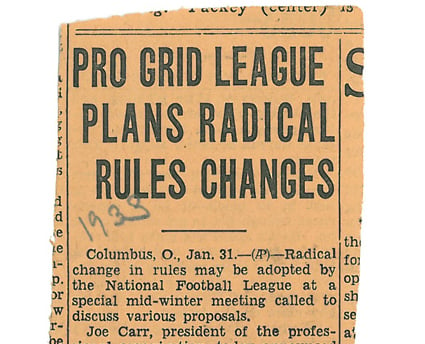Airing it out!
2/25/2011

The National Football League held an owners meeting at the Fort Pitt Hotel in Pittsburgh on February 25-26, 1933. The meeting on Saturday the 25th was called to order by NFL President Joe F. Carr at 1:00 p.m. ET.
Over the next several hours, sweeping changes were made to the NFL’s playing rules. Chief among the revisions was the sixth motion of the meeting. Per the official meeting minutes from that session which are a part of the Pro Football Hall of Fame’s collection, Boston Redskins owner George Preston Marshall made the motion that was seconded by Chicago Bears owner George Halas.
“…that the rule covering the use of the forward pass, whereby it is necessary for the passer to be at least five yards behind the line of scrimmage before he can pass the ball, be changed permitting the passer to pass the ball from any point behind the line of scrimmage.”
The motion was passed unanimously and with that the NFL entered a new era with a more wide-open style of play.The future of passing
Unencumbered by the rules, it wasn't long before the league had its first 1,000-yard passer. That came in 1936 when the Green Bay Packers Arnie Herber threw 173 times for 1,239 yards. Another Packers QB was the NFL’s first 2,000-yard passer. Green Bay’s Cecil Isbell completed 146 of 268 passes for 2,021 yards in 1942.It wasn’t until the 1960 season that pro football had a passer eclipse 3,000 yards through the air in one season. The Baltimore Colts Johnny Unitas of the NFL and Jack Kemp of the AFL’s Los Angeles Chargers hold the distinction of being first to reach the 3,000-yard mark.
Joe Namath of the New York Jets was first to throw for 4,000 yards in a season. He accomplished that feat in 1967. Another 4,000-yard passer didn’t surface until Dan Fouts in 1979. Five years later in 1984, future Hall of Fame quarterback Dan Marino became the first player in history to reach 5,000 yards passing in a single season.
Huddle Up
A variety of rule changes were discussed at the 1933 meeting. Several were passed unanimously, others were shot down and one by Marshall didn’t even receive a second. He had proposed that the huddle be abolished and that any team that went into a huddle should be charged with a timeout.PAT ruled unfair?
Newspaper reports leading up to the meeting claimed that the owners were surely going to eliminate the point-after-attempt following touchdowns. The rationale for this proposed rule change was that weather conditions sometimes gave one team an advantage over another in evenly-contested games with much scoring. The change was never brought to the table. However, there was more debate about the extra point that day. One motion that was later withdrawn focused on moving the location of the point-after-attempt from the center of the field to the spot where the ball crossed the goal line. Another proposal called for the extra point to be attempted from the three-yard-line instead of the two. That motion lost.Prolate Spheroid
The 1899 Official Football Rules Book expanded the definition of the football to include a description of its shape. It read, "the football used shall be of leather, enclosing an inflated rubber bladder. The ball shall have the shape of a prolate spheroid."
As the rules around the forward pass changed so too did the shape of the football. See our photo gallery of the evolution of the football.
Go back to all blog listings

